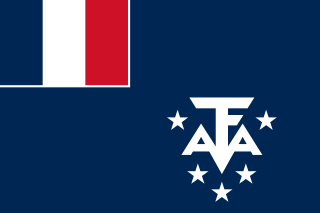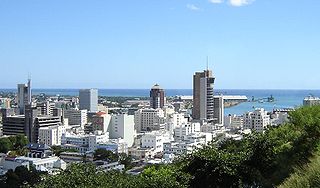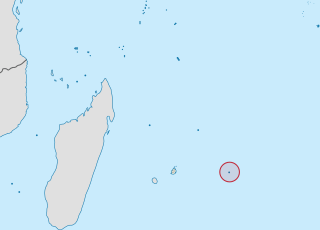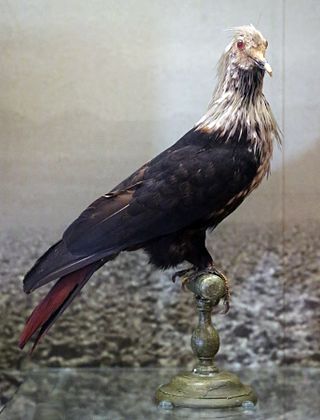Contents
This article includes a list of references, related reading, or external links, but its sources remain unclear because it lacks inline citations .(April 2023) |
This is a list of museums in Mauritius .
This article includes a list of references, related reading, or external links, but its sources remain unclear because it lacks inline citations .(April 2023) |
This is a list of museums in Mauritius .

The dodo is an extinct flightless bird that was endemic to the island of Mauritius, which is east of Madagascar in the Indian Ocean. The dodo's closest relative was the also-extinct and flightless Rodrigues solitaire. The two formed the subtribe Raphina, a clade of extinct flightless birds that were a part of the family which includes pigeons and doves. The closest living relative of the dodo is the Nicobar pigeon. A white dodo was once thought to have existed on the nearby island of Réunion, but it is now believed that this assumption was merely confusion based on the also-extinct Réunion ibis and paintings of white dodos.

Mauritius, officially the Republic of Mauritius, is an island country in the Indian Ocean, about 2,000 kilometres off the southeastern coast of East Africa, east of Madagascar. It includes the main island, as well as Rodrigues, Agaléga, and St. Brandon. The islands of Mauritius and Rodrigues, along with nearby Réunion, are part of the Mascarene Islands. The main island of Mauritius, where the population is concentrated, hosts the capital and largest city, Port Louis. The country spans 2,040 square kilometres (790 sq mi) and has an exclusive economic zone covering 2,300,000 square kilometres.
The known and sometimes formally documented history of Mauritius begins with its possible discovery by Austronesians under the Austronesian expansion from pre-Han Taiwan, circa 1500 to 1000 BC, and then by Arabs,, followed by Portuguese and its appearance on European maps in the early 16th century. Mauritius was successively colonized by the Netherlands, France and Great Britain, and became independent on 12 March 1968.

Tromelin Island, once called the Isle of Sand, is a low, flat island in the Indian Ocean about 500 km north of Réunion and about 450 km east of Madagascar. Tromelin is part of the Scattered Islands in the Indian Ocean, the fifth district of the French Southern and Antarctic Lands, a French Overseas Territory, but Mauritius claims sovereignty over the island.

Port Louis is the capital and most populous city of Mauritius, mainly located in the Port Louis District, with a small western part in the Black River District. Port Louis is the country's financial and political centre. It is administered by the Municipal City Council of Port Louis. According to the 2018 census conducted by Statistics Mauritius, the population was 147,066.

Rodrigues is a 108 km2 (42 sq mi) autonomous outer island of the Republic of Mauritius in the Indian Ocean, about 560 km (350 mi) east of Mauritius. It is part of the Mascarene Islands, which include Mauritius and Réunion. Like Agaléga, Rodrigues is a constituent island of the Republic of Mauritius, under the Constitution of Mauritius and still remains, as explicitly defined by the same Constitution, part of the Sovereignty of Mauritius, together with the following islands: "Agalega, Tromelin, Cargados Carajos, Chagos Archipelago ... Diego Garcia and other islands included in the State of Mauritius".

The Mauritius "Post Office" stamps were issued by the British Colony Mauritius in September 1847, in two denominations: an orange-red one penny (1d) and a deep blue two pence (2d). Their name comes from the wording on the stamps reading "Post Office", which was soon changed in the next issue to "Post Paid". They are among the rarest postage stamps in the world.
Sookdeo Bissoondoyal was a Mauritian politician and one of the leading figures in the nation's independence movement.

Mauritians are nationals or natives of the Republic of Mauritius and their descendants. Mauritius is a melting pot of multi-ethnic, multi-cultural and multi-religious peoples. Mauritian is made up of blended groups of people who come mainly from South Asian, African, European, and Chinese descent, as well as those of a mixed background from any combination of the aforementioned ethnic groups. Creol-Mauritian is the blending of the different cultures; this is why it is complex to define Creol-Mauritian.

The Mauritius blue pigeon is an extinct species of blue pigeon formerly endemic to the Mascarene island of Mauritius in the Indian Ocean east of Madagascar. It has two extinct relatives from the Mascarenes and three extant ones from other islands. It is the type species of the genus of blue pigeons, Alectroenas. It had white hackles around the head, neck and breast and blue plumage on the body, and it was red on the tail and the bare parts of the head. These colours were thought similar to those of the Dutch flag, a resemblance reflected in its French common name, Pigeon Hollandais. The juveniles may have been partially green. It was 30 cm (12 in) long and larger and more robust than any other blue pigeon species. It fed on fruits, nuts, and molluscs, and was once widespread in the forests of Mauritius.

Cylindraspis is a genus of recently extinct giant tortoises. All of its species lived in the Mascarene Islands in the Indian Ocean and all are now extinct due to hunting and introduction of non-native predators.
The State House is the official residence of the President of Mauritius. Originally Le Réduit, it was built as a fortress for defence against attack by Pierre Félix Barthelemy David in 1749. The mansion is in Réduit, Moka, near of the University of Mauritius and the end of the Plaines Wilhems District. It used to serve as the residence for former governors of Mauritius, but now it is the residence of the President. It is built on 97 hectares of land. The château has a garden where a multitude of flowers grow, as well as exotic and native trees. The château is open to the public two days a year, in October and March. The house has persisted through history; it was destroyed by a cyclone, rebuilt, and has been renovated since. It is also used by the military.
The following is an index of Mauritius-related topics by alphabetical order. For a list by topic, see list of Mauritius-related topics

The history of the Jews in Mauritius goes back to the first Jews who arrived in Mauritius from Haifa, British Palestine, in the 1940s because they were denied entry to Palestine by the British Government.
Natural History Museum or Museum of Natural History may refer to:
The Truth and Justice Commission of Mauritius was an independent truth commission established in 2009, which explored the impact of slavery and indentured servitude in Mauritius. The Commission was tasked to investigate the dispossession of land, and “determine appropriate measures to be extended to descendants of slaves and indentured laborers.” It was “unique in that it [dealt] with socio-economic class abuses" and explored the possibility of reparations. The inclusion of reparations, whether for individuals or communities, was a controversial decision within the country which aimed to correct inequality. The Commission attempted to cover more than 370 years, the longest period of time that a truth commission has ever covered.
The following is a timeline of the history of the city of Port Louis on the island of Mauritius.

Israel–Mauritius relations are the bilateral relations between the State of Israel and the Republic of Mauritius. The Israeli embassy in Nairobi, Kenya is accredited to Mauritius. Mauritius has an honorary consul in Tel Aviv, Regev Naftali.